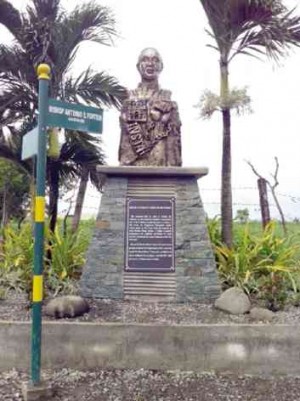Remembering Fortich, ‘bishop of the poor’

THE STATUE of Bishop Antonio Fortich is unveiled at the reclamation area in Bacolod City. CARLA P. GOMEZ/INQUIRER VISAYAS
BACOLOD CITY—In Negros Occidental, he was known as the “bishop of the poor” for championing the cause of the masses.
Many Negrenses continue to revere Bishop Antonio Fortich, who died on July 2, 2003, at the age of 90 and whose works and ideals are now immortalized in a book and a statue that were launched and unveiled last week.
“Vir Fortis,” a compilation of four articles on Fortich, was launched on Aug. 10, the eve of his 100th birthday, at St. Mary’s Monastery of the Redemptorist Church in Bacolod City.
The next day, a statue of the bishop was unveiled at the reclamation area, across the street from the Pope John Paul II tower and statue.
The events highlighted the weeklong festivities dubbed “Insta: A Festival of Faith” to celebrate the birth centenary of Fortich, a bishop for 22 years and a priest for 50 years, on Aug. 11.
Article continues after this advertisementSocial critic
Article continues after this advertisementIn 1989, Fortich received a Nobel Peace Prize nomination for being a strong advocate of the rights of the poor and a critic of an unjust social economic system.
He received the Ramon Magsaysay Award, the Asian equivalent of the Nobel Peace prize, for public service in 1973 for being a “prime mover of social change” in the province. The award was bestowed on him for his pioneering work in establishing the Dacongcogon Cooperative Sugar Mill project in Kabankalan City.
Fortich organized sugar workers in Dacongcogon Valley into a cooperative and made them owners of the sugar mill. (The mill was shut down recently.)
Ten years after his death, “Vir Fortis” was published. Its four articles were written by four priests who worked under him—Msgr. Victorino Rivas, who was chancellor secretary and vicar general of the diocese during the episcopacy of Fortich; Msgr. Toto Suplido, then social action director, chancellor secretary and oeconomus; Fr. Romeo Empestan, diocesan pastoral director; and Fr. Dimitri Gatia, a scholar for biblical studies and Fortich’s companion during his speaking engagements abroad.
Strength, courage
According to Suplido, the book’s title was derived from a Latin phrase roughly translated to “a man of strength and courage,” which the late bishop had displayed, especially during the martial law regime of President Ferdinand Marcos in the 1970s.
He recalled that Fortich fought for the rights of the priests and activists who were imprisoned, as well as families of victims of desaparecidos.
“He was able to convince the martial law government to establish the church military liaison committee nationally and locally, which heard and investigated alleged military abuses,” Suplido said. “Although this didn’t not solve all such problems, it did mitigate injustices and, in some cases, save lives.”
Because of his efforts, Fortich was called “Kumander Tony.”
Statue
His statue was made by
Bro. Jaazeal Jakosalem, who considered the project a learning in progress because he tried to incorporate the mission Fortich journeyed with the people of Negros Occidental, with emphasis on promoting a church for the poor.
The 6-foot statue on a 6-foot base is made of fiberglass and is colored bronze.
On its body are the letters “INSTA,” which represents Fortich’s motto: Insist to preach the Gospel in and out of season.
Engraved are maong pants, a sugar mill and a dove. The pants represent one of the bishop’s livelihood projects—the manufacturing of denim jeans for sugar workers.
The mill is a reminder that he started the Dacongcogon Cooperative Mill while the dove symbolizes Fortich’s quest for peace.
Born on Aug. 11, 1913, Fortich was the eldest child of Ignacio Fortich, a Spanish mestizo, and Rosalia Yapsutco, who was half Chinese.
Rich family
The family was wealthy and owned tracks of land planted to rice, corn and sugar in Sibulan town, Negros Oriental. They also owned fishponds and turn-of-the-century sugar mill producing brown sugar called muscovado.
Unlike other children of wealthy families, Fortich was made to help in the farm and mill to earn money. It was during those years that he witnessed the hard life of the ordinary folk.
On March 4, 1944, at the height of World War II, Fortich, then 28 years old, was ordained by Michael O’Doherty, archbishop of Manila. He was first assigned to Bacolod City and was active in work that empowered the poor.
When he became the bishop, he created the Catholic Church’s Social Action Committee to make the diocese responsive to the needs of the time.
At the time, the committee was headed by Fr. Luis Jalandoni, who later left the priesthood and is now the spokesperson of the communist-led National Democratic Front based in the Netherlands.
One of the biggest triumphs of Fortich was to get Pope John Paul II to make a side trip to Negros during his visit to the Philippines in 1981.
When Fortich, then 80 years old, was asked when his mission would end, he replied: “When the country attains peace, because that will mean that the needs of the poor will have been answered.”